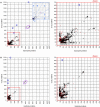Poxvirus protein evolution: family wide assessment of possible horizontal gene transfer events
- PMID: 19464330
- PMCID: PMC2779260
- DOI: 10.1016/j.virusres.2009.05.006
Poxvirus protein evolution: family wide assessment of possible horizontal gene transfer events
Abstract
To investigate the evolutionary origins of proteins encoded by the Poxviridae family of viruses, we examined all poxvirus protein coding genes using a method of characterizing and visualizing the similarity between these proteins and taxonomic subsets of proteins in GenBank. Our analysis divides poxvirus proteins into categories based on their relative degree of similarity to two different taxonomic subsets of proteins such as all eukaryote vs. all virus (except poxvirus) proteins. As an example, this allows us to identify, based on high similarity to only eukaryote proteins, poxvirus proteins that may have been obtained by horizontal transfer from their hosts. Although this method alone does not definitively prove horizontal gene transfer, it allows us to provide an assessment of the possibility of horizontal gene transfer for every poxvirus protein. Potential candidates can then be individually studied in more detail during subsequent investigation. Results of our analysis demonstrate that in general, proteins encoded by members of the subfamily Chordopoxvirinae exhibit greater similarity to eukaryote proteins than to proteins of other virus families. In addition, our results reiterate the important role played by host gene capture in poxvirus evolution; highlight the functions of many genes poxviruses share with their hosts; and illustrate which host-like genes are present uniquely in poxviruses and which are also present in other virus families.
Figures





References
-
- Botstein D. A theory of modular evolution for bacteriophages. Ann. N. Y. Acad. Sci. 1980;354:484–490. - PubMed
-
- Condit R.C., Moussatche N., Traktman P. In a nutshell: structure and assembly of the vaccinia virion. In: Maramorosch K., Shatkin A.J., editors. vol. 66. Academic Press; 2006. pp. 31–124. (Advances in Virus Research). - PubMed
Publication types
MeSH terms
Substances
Grants and funding
LinkOut - more resources
Full Text Sources
Research Materials

